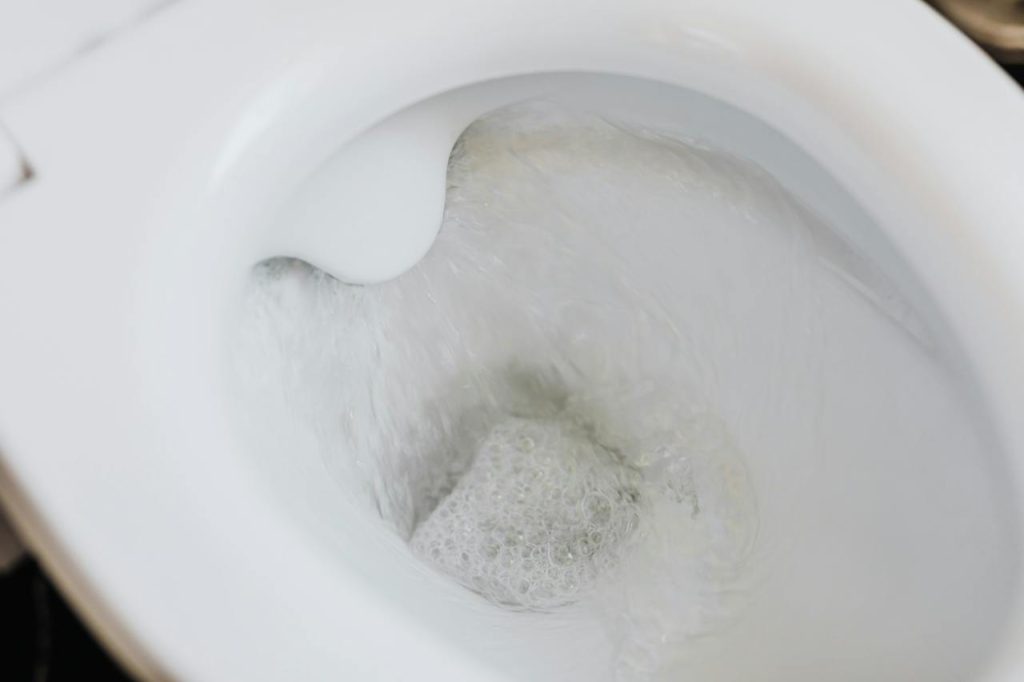A functioning toilet is something we often take for granted. However, even the most reliable toilets can experience issues from time to time. It’s important to be aware of the common signs that indicate your toilet may be malfunctioning and in need of attention.
From mysterious leaks and persistent clogs to unusual noises and inconsistent flushing, these are all red flags that something might be wrong with your toilet. Ignoring these signs can lead to more significant problems down the line, such as water damage or costly repairs.
We’ll also provide an overview of common toilet problems and offer tips on how to troubleshoot and fix them yourself or when it might be necessary to call in a professional plumber.
Table of Contents
ToggleSign #1: Water Leaks At The Base: Identifying And Fixing Toilet Base Leaks
Causes Of Water Leaks At The Base
Water leaks at the base of a toilet can be caused by various factors. One common cause is a deteriorated wax ring that seals the connection between the toilet and the floor drain. Over time, this wax ring can wear out or become damaged, leading to water seepage. Another possible cause is a loose or cracked toilet flange, which is the pipe fitting that connects the toilet to the sewer line. If the flange is not securely fastened or has cracks, it can allow water to escape onto your bathroom floor.
Steps To Identify A Toilet Base Leak
Identifying a toilet base leak requires some simple steps. First, check for any visible signs of water around the base of your toilet. Look for puddles or wet spots on the floor. Next, inspect the area where your toilet meets the floor. If you notice any discoloration or dampness in this area, it could indicate a leak. To further confirm if there’s a leak, try wiggling your toilet gently back and forth. If you feel movement or hear a squishing sound, it’s likely there’s a problem with the seal.
Repair Options For Fixing Base Leaks
Once you’ve identified a water leak at the base of your toilet, it’s essential to take prompt action to prevent further damage and waste of water. Depending on the severity of the leak and its underlying cause, you may have several repair options available:
- Replace Wax Ring: If a worn-out wax ring is causing the leak, replacing it can solve the issue. This involves removing and reseating your toilet after installing a new wax ring.
- Tighten Toilet Flange: If you suspect that a loose flange is causing water leakage, try tightening its bolts using an adjustable wrench.
- Repair Cracked Flange: In the case of a cracked flange, it may be necessary to replace the damaged part. This repair requires some plumbing expertise and is best left to professionals.
Importance Of Professional Assistance For Complex Leaks
While minor toilet base leaks can sometimes be fixed by homeowners, more complex issues may require professional assistance. Hiring a plumber experienced in toilet repairs ensures that the leak is accurately diagnosed and effectively resolved. Professionals have the necessary tools and expertise to handle more intricate repairs such as replacing or repairing a cracked flange. Attempting complicated repairs without proper knowledge can potentially worsen the problem and lead to additional expenses.
Toilet base leaks should never be ignored, as they can cause significant water damage to your bathroom floor and increase your water bill. By promptly identifying and addressing these leaks, you can prevent further complications and maintain a well-functioning toilet.
Sign #2: Cracked Tank Lid: Understanding And Addressing Cracks In The Toilet Tank Lid
Cracks in the toilet tank lid can be a real pain, causing leaks, water wastage, and potential damage to your bathroom floor. It’s important to understand the reasons behind these cracks and how to address them effectively. Let’s explore some key points about cracked tank lids.
Reasons Behind Cracked Tank Lids
There are several reasons why a toilet tank lid may develop cracks:
- Age and wear: Over time, the materials used in toilet tank lids can deteriorate due to constant exposure to moisture and fluctuating temperatures.
- Impact or accidental damage: Dropping heavy objects on the lid or accidentally hitting it with a sharp object can cause cracks.
- Poor installation: If the lid is not installed properly or tightened too much, it can lead to stress on the material, resulting in cracks.
- Manufacturing defects: In some cases, there may be inherent flaws or weaknesses in the manufacturing process that make the lid prone to cracking.
Signs Of A Cracked Tank Lid
It’s essential to keep an eye out for signs that indicate a cracked tank lid:
- Visible cracks: Inspect your toilet tank lid regularly for any visible cracks or fractures.
- Water leakage: If you notice water seeping out from around the edges of the tank lid when you flush or fill up the toilet, it could be an indication of a crack.
- Unstable lid: A cracked lid may become loose or wobble when touched due to compromised structural integrity.
DIY Solutions For Minor Cracks
If you discover minor cracks in your toilet tank lid, there are some simple steps you can take to address them:
- Apply adhesive sealant: Use an adhesive sealant specifically designed for repairing porcelain or ceramic surfaces. Apply it carefully over the crack and allow it to dry completely before using the toilet.
- Use epoxy putty: Another option is to use epoxy putty, which can be molded and applied over the crack. Follow the manufacturer’s instructions for proper application and drying time.
Replacing A Severely Damaged Tank Lid
In cases where the cracks are severe or extensive, it may be necessary to replace the entire toilet tank lid. Here’s what you need to do:
- Measure and purchase: Measure the dimensions of your current tank lid and purchase a suitable replacement from a hardware store or online retailer.
- Remove the old lid: Carefully lift off the old cracked lid by unscrewing any bolts or nuts that hold it in place.
- Install the new lid: Place the new lid on top of the tank, aligning it properly with any openings or fixtures, and secure it tightly using bolts or nuts.
Remember, if you’re unsure about handling cracked tank lids yourself, it’s always best to consult a professional plumber who can provide expert guidance.
To sum up, cracked tank lids in toilets can lead to water leaks and other issues. Understanding why these cracks occur and knowing how to address them is crucial for maintaining a functioning bathroom. Regular inspections, DIY repairs for minor cracks, and replacement for severe damage are all key steps in keeping your toilet running smoothly.
Sign #3: Constant Clogging: Solutions For Persistent Toilet Clogs
Is your toilet misbehaving? Are you constantly dealing with the frustration of a clogged toilet? Well, you’re not alone! Many households face the common issue of persistent toilet clogs. But fear not, because, in this section, we’ll discuss the common causes of these clogs and provide you with effective techniques to unclog your toilet. We’ll also share preventive measures to avoid frequent clogging and let you know when it’s time to seek professional help.
Common Causes Of Persistent Clogs
Toilet clogs can be caused by various factors within your plumbing system. Some common culprits include:
- Excessive Toilet Paper Usage: Using an excessive amount of toilet paper can overwhelm your plumbing system and lead to clogs.
- Flushing Non-Flushable Items: Flushing items like baby wipes, sanitary products, or cotton balls down the toilet can quickly result in stubborn clogs.
- Buildup of Mineral Deposits: Over time, minerals from hard water can accumulate inside the drain line, narrowing its diameter and causing blockages.
- Tree Root Intrusion: In some cases, tree roots may infiltrate the underground drain pipes through cracks or joints, causing severe blockages.
Techniques To Unclog Toilets Effectively
When faced with a persistent clog in your toilet, there are several techniques you can try before calling a plumber:
- Plunger Power: A plunger is a handy tool that uses suction to dislodge stubborn clogs. Ensure a tight seal between the plunger and the drain opening before vigorously plunging up and down.
- Plumbing Snake Savior: A plumbing snake (also known as a drain auger) is a long flexible wire that can reach deep into the pipes to break up or remove obstructions causing the clog.
- Hot Water Heroics: Pouring hot water into the toilet bowl can help dissolve certain types of clogs, particularly those caused by excessive toilet paper or organic matter. Be cautious not to use boiling water, as it may crack the porcelain.
- DIY Drain Pro: Homemade drain cleaners made with baking soda and vinegar can be effective in breaking down clogs caused by organic matter. Simply pour a cup of baking soda followed by a cup of vinegar into the toilet and let it sit for a while before flushing.
Preventive Measures To Avoid Frequent Clogging
Prevention is always better than dealing with persistent clogs. Here are some preventive measures you can take:
- Use less toilet paper: Be mindful of how much toilet paper you use and avoid excessive amounts that could lead to clogs.
- Don’t flush non-flushable items: Remember, only human waste and toilet paper should be flushed down the toilet.
- Regular maintenance: Schedule regular inspections and maintenance for your plumbing system to catch any potential issues before they become major problems.
When To Seek Professional Help For Stubborn Clogs
While many clogs can be resolved using DIY techniques, there are times when it’s best to call in a professional plumber:
- Multiple fixtures affected: If multiple toilets or drains in your home are experiencing slow drainage or backups, it may indicate a larger issue within your plumbing system that requires professional attention.
- Repeated clogs: If you find yourself constantly dealing with stubborn clogs despite your best efforts, it’s time to bring in an expert who can identify the underlying cause and provide long-term solutions.
Remember, tackling persistent toilet clogs requires patience and persistence. By understanding the common causes of these clogs, utilizing effective unclogging techniques, taking preventive measures, and knowing when to seek professional help, you’ll be well-equipped to handle any misbehaving toilets that come your way!
Sign #4: Odor Problems: Dealing With Unpleasant Smells From The Toilet
Foul odors coming from your toilet can be quite unpleasant. There are several possible reasons why your toilet may be emitting these smells, but don’t worry, there are ways to eliminate them and keep your bathroom smelling fresh.
Possible Reasons For Foul Odors From Toilets
- Clogged Drains: When waste and debris accumulate in the drain pipes, it can lead to foul odors. The buildup of organic matter like hair, soap scum, and other particles can create a breeding ground for bacteria that produce unpleasant smells.
- Leaky Seals: The wax seal or rubber gasket around the base of the toilet can deteriorate over time, causing leaks. These leaks not only result in water damage but also allow sewer gases to escape into your bathroom, resulting in foul odors.
- Insufficient Ventilation: Proper ventilation is essential to prevent lingering smells in the bathroom. If your bathroom lacks proper ventilation or if the vent pipe connected to your toilet is blocked or damaged, it can contribute to odor problems.
Tips On Eliminating Toilet Odors
- Regular Cleaning: Keeping your toilet clean is crucial in preventing odor issues. Regularly scrubbing the bowl with a toilet brush and using a mild cleaner will help remove any buildup of bacteria or mold that could be causing the smell.
- Check for Leaks: Inspect the area around the base of your toilet for any signs of water leakage. If you notice any dampness or discoloration, it may indicate a faulty wax seal or gasket that needs replacement.
- Improve Ventilation: Ensure that there is proper airflow in your bathroom by opening windows or using an exhaust fan while using the toilet or taking showers. This will help remove any stale air and prevent odors from lingering.
Cleaning Techniques To Remove Odor-Causing Bacteria
- Vinegar and Baking Soda: Mix equal parts of vinegar and baking soda to create a natural cleaning solution. Pour this mixture into the toilet bowl, scrub it with a brush, and let it sit for a few minutes before flushing. The acidic properties of vinegar will help eliminate bacteria and neutralize odors.
- Bleach or Disinfectant: Using bleach or a disinfectant specifically designed for toilets can be effective in killing odor-causing bacteria. Follow the instructions on the product label and use caution when working with these chemicals.
Using Deodorizing Products As A Temporary Solution
- Toilet Deodorizers: There are various deodorizing products available in the market that can help mask unpleasant odors temporarily. These products come in the form of tablets, gels, or sprays that can be placed in the toilet tank or directly applied to the bowl.
- Air Fresheners: Placing an air freshener near your toilet can provide immediate relief from foul odors. However, keep in mind that air fresheners only mask the smell and do not address the underlying cause of the problem.
Remember, while deodorizing products may provide temporary relief, it is essential to identify and address the root cause of toilet odors for a long-term solution.
Sign #5: Aging And Surface Damages: Recognizing Signs Of Wear And Tear On Your Toilet
As toilets age, they can start to show signs of wear and tear. It’s important to recognize these indications so you can address them before they turn into bigger problems. Here are some common signs that your toilet may be aging or damaged:
Scratches And Damage
One of the most obvious signs of wear and tear on a toilet is visible scratches or damage on the surface. Over time, repeated use, cleaning, and accidental drops can lead to scratches or chips in the porcelain. These imperfections not only affect the appearance of your toilet but can also impact its functionality.
Leaks
Another indication that your toilet may be experiencing wear and tear is the presence of leaks. If you notice water pooling around the base of your toilet or detect a constant running sound even when it’s not in use, it could be a sign that there are cracks or faulty seals causing water to escape.
Difficulty Flushing
If you find yourself having to flush multiple times for waste to go down properly, it could be an indication that your toilet is aging. Over time, internal components like flappers and valves can deteriorate, resulting in reduced flushing power.
Constant Clogs
Frequent clogs are another sign that your toilet may be misbehaving due to wear and tear. As toilets age, mineral deposits can accumulate within the pipes, leading to blockages. Worn-out parts may not create enough suction for effective flushing, causing clogs more frequently.
Reduced Water Efficiency
An aging toilet may also exhibit reduced water efficiency over time. Older models tend to use more water per flush compared to newer ones designed with water-saving features. If you notice an increase in your water bill without any change in usage habits, it could be a sign that your toilet is no longer as efficient as it once was.
To extend the lifespan of your toilet and address these signs of wear and tear, regular maintenance is crucial. Here are some maintenance practices you can follow:
- Clean the toilet regularly using non-abrasive cleaners to prevent scratches and damage.
- Check for leaks by inspecting the base, tank, and connections regularly.
- Replace worn-out parts like flappers or valves to maintain proper flushing performance.
- Use a plunger or a plumbing snake to clear minor clogs before they become major issues.
- Consider upgrading to a newer, more water-efficient toilet model if repairs are no longer sufficient.
By being proactive in maintaining your toilet, you can prolong its lifespan and avoid costly repairs or replacements. Remember, prevention is always better than cure.
Sign #6: Malfunctioning Flush Handle: Troubleshooting And Repairing A Corroded Flush Handle
Symptoms Of A Malfunctioning Flush Handle
Is your toilet misbehaving? One common sign of a malfunctioning toilet is a flush handle that doesn’t work properly. If you’re experiencing any of the following symptoms, it’s likely that your flush handle is corroded and in need of repair:
- The handle feels loose or wobbly when you try to flush.
- You have to jiggle or hold down the handle for the toilet to flush.
- The flush lever gets stuck or doesn’t return to its original position after flushing.
Steps To Diagnose A Corroded Flush Handle
To determine if your flush handle is indeed corroded, follow these simple steps:
- Lift off the tank lid and locate the flush handle mechanism.
- Inspect the metal rod connecting the handle to the flapper chain.
- Look for signs of rust, corrosion, or any visible damage on the rod and surrounding components.
If you notice any corrosion or damage, it’s likely that your flush handle needs attention.
DIY Repair Methods For Fixing Or Replacing It
Repairing or replacing a corroded flush handle can be done easily with some basic tools and DIY knowledge. Here are a few methods you can try:
- Clean and lubricate: Start by cleaning off any rust or grime from the metal rod using a wire brush or steel wool. Apply some lubricant, such as WD-40, to ensure smooth movement.
- Adjust chain length: If the chain connecting the flapper valve to the flush lever is too long or too short, it can cause issues with flushing. Adjust its length accordingly so that there’s just enough slack for proper operation.
- Replace flapper valve: In some cases, a worn-out flapper valve can lead to problems with flushing. Consider replacing the flapper valve if it’s damaged or not sealing properly.
- Replace the flush handle: If the corrosion is extensive or the handle is beyond repair, it’s best to replace it with a new one. You can find replacement handles at your local hardware store.
Remember, if you’re not confident in your DIY skills, it’s always a good idea to consult a professional plumber for assistance.
Benefits Of Regular Maintenance To Prevent Future Issues
Taking care of your toilet and performing regular maintenance can help prevent future problems with your flush handle. Here are some benefits of keeping up with toilet maintenance:
- Avoid costly repairs: By addressing minor issues early on, you can prevent them from turning into major and expensive repairs down the line.
- Improve efficiency: A well-maintained toilet operates more efficiently, saving water and reducing utility bills.
- Extend lifespan: Regular maintenance helps prolong the lifespan of your toilet, preventing premature replacements.
- Maintain hygiene: Properly functioning toilets ensure proper waste removal and maintain cleanliness in your bathroom.
By following these troubleshooting tips and practicing regular maintenance, you can keep your flush handle working smoothly and avoid any unnecessary headaches in the future.
Conclusion: Understanding And Addressing Malfunctioning Toilets
In conclusion, a malfunctioning toilet can cause various issues in your bathroom, ranging from water leaks and constant clogging to unpleasant odors and surface damage. By recognizing the signs of these problems, you can take proactive steps to address them and ensure your toilet is functioning properly. Fixing a leaking base requires identifying the source of the leak and applying appropriate sealants or replacing faulty components. Cracks in the tank lid can be resolved by either repairing or replacing it entirely.
Persistent clogs can often be alleviated by using a plunger or employing drain-clearing methods such as using a plumbing snake or enzyme-based cleaners. Unpleasant smells from the toilet can be eliminated by cleaning thoroughly and using deodorizing products specifically designed for toilets. Recognizing signs of wear and tear on your toilet, such as aging or surface damage, allows you to decide whether repair or replacement is necessary. Lastly, troubleshooting and repairing a corroded flush handle involves inspecting for rust or mineral deposits, cleaning or lubricating the mechanism, or replacing it if needed.
To ensure your bathroom remains functional and hygienic, it is essential to promptly address any issues with your toilet. By understanding common signs of malfunctioning toilets and following the recommended solutions provided in this blog post, you can save yourself from potential headaches down the line. Remember to regularly inspect your toilet for leaks, cracks, clogs, odors, and surface damage to catch any problems early on.
Looking For A Reliable Malfunctioning Toilet Repair Team?
Look no further than Garcia Home Restoration! We are your go-to experts for all your toilet and plumbing needs. Our licensed and insured team delivers top-notch services that will leave you impressed.
We cover it all, from toilet repairs and replacements to clog removal and water-efficient upgrades. We’re also experts in bathroom mold remediation and plumbing-related damage repair. No matter the issue, we have the skills to restore your bathroom to its former glory.
At Garcia Home Restoration, our commitment is unwavering. We provide exceptional service to homeowners throughout Contra Costa County and beyond. With satisfied repeat customers and glowing referrals, we take immense pride in our quality workmanship.
Don’t hesitate! Contact us today, and let us be your trusted partner in fixing your malfunctioning toilet. Experience the difference our dedicated team can make in bringing your bathroom back to life!




